新视野大学英语4第三版第四册第三单元教案
- 格式:doc
- 大小:50.00 KB
- 文档页数:5
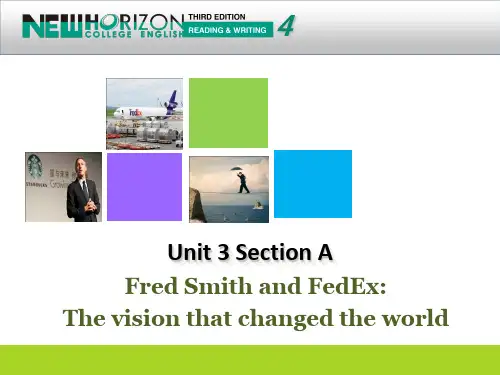
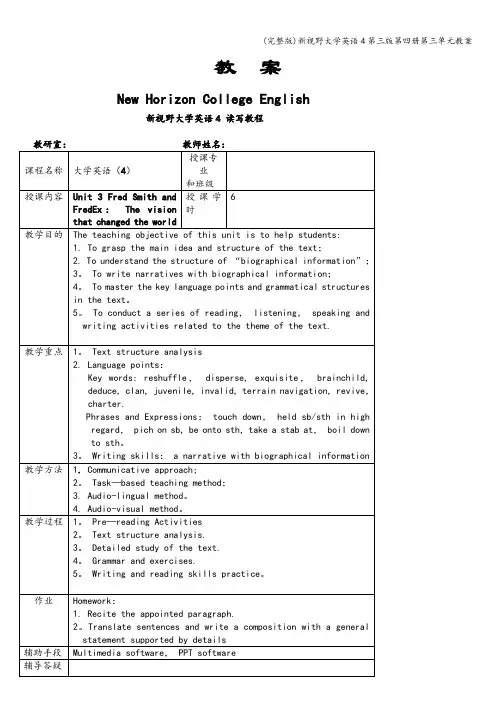
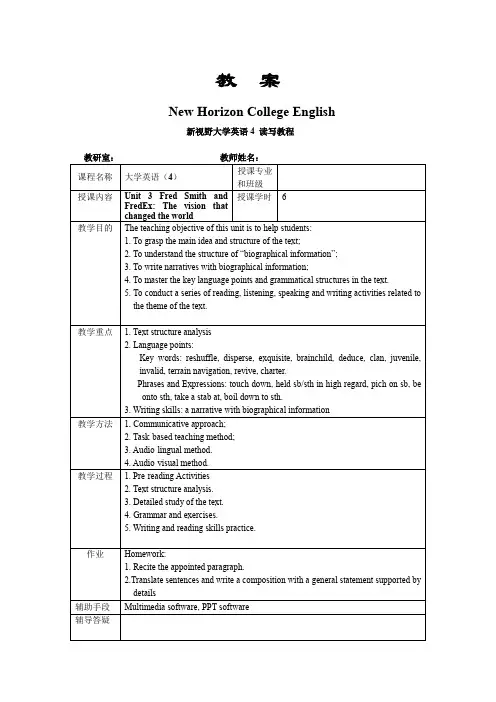
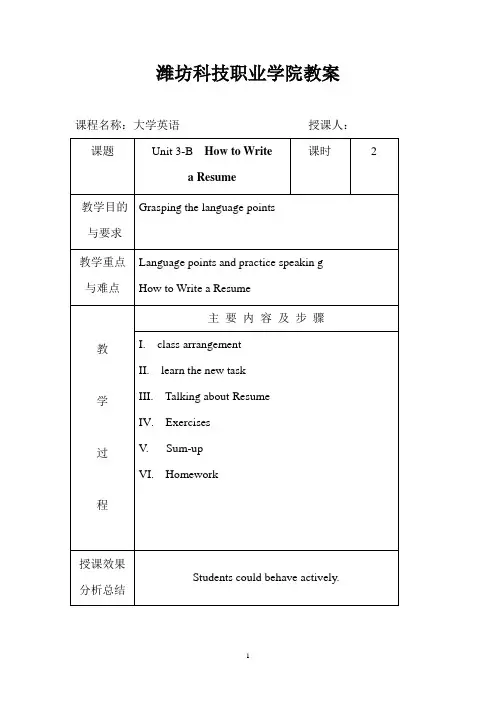
潍坊科技职业学院教案课程名称:大学英语授课人:How to Write a Resume一.New words and expressionsAppropriate adj. 恰当的;合适的Environment n. [C; U] 环境;周围情况Establish vt. 订立;制定;确立self-assessment n. [U] 自我评估;自我估价prior adj. (to) 在……之前;先于elaborate v. 详述;详尽说明assist vt. 帮助;协助overload v. 使超载;使负担过重format n. [C] 设计;安排;格式chronological adj. 按时间顺序排列的reverse adj. 相反的consideration n. [C] 要考虑的事实(或因素) 2. [U] 考虑;斟酌layout n. [C] 布局;设计;安排organization n. (organisation BrE) [C] 团体;组织;机构initiative n. [U]主动性;首创精神contribution n. [C] 贡献innocent adj. 1. 无害的;没有恶意的 2. 清白无罪的;无辜的solid adj. 出色的;扎实的applicant n. [C] 申请人take the initiative采取主动;首先采取行动above all最重要的是set about开始做;着手做put one's best foot forward尽力留下好印象;尽最大努力二.Language points1. A resume is a business document that outlines your work experience, education, and skills on paper.Meaning: A resume is a business statement that gives the main points of your work experience, education and skills.on paper: written on paper; in writing 在纸上;以书面形式It's only a suggestion on paper. 这仅仅是书面形式的建议。
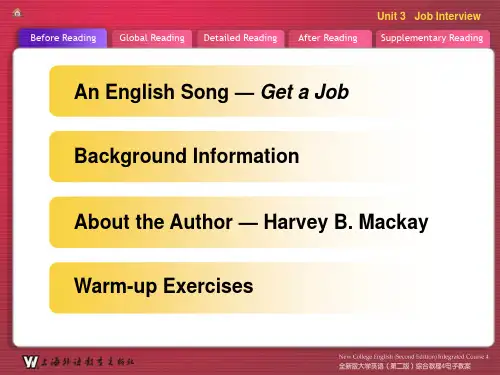
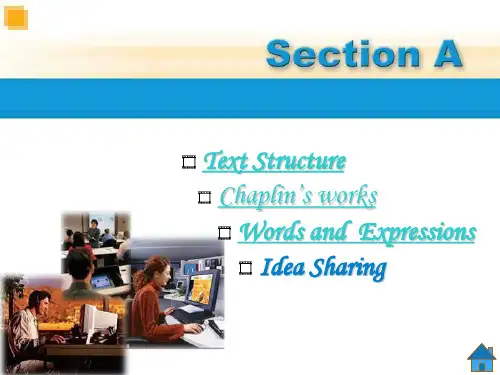
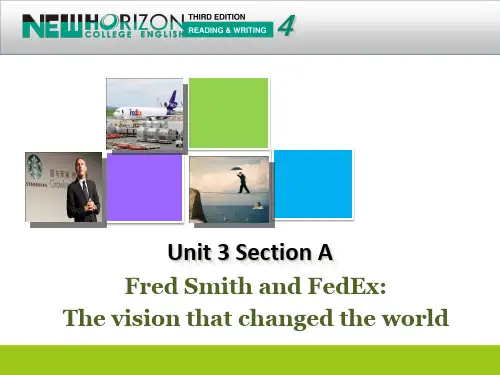
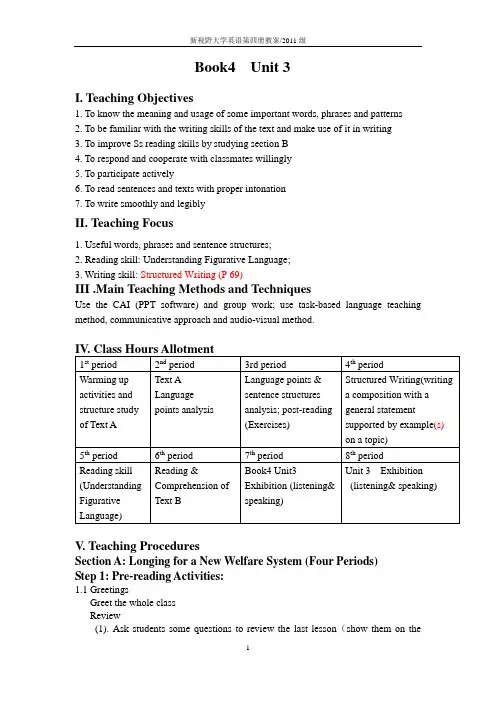
Book4 Unit 3I. Teaching Objectives1. To know the meaning and usage of some important words, phrases and patterns2. To be familiar with the writing skills of the text and make use of it in writing3. To improve Ss reading skills by studying section B4. To respond and cooperate with classmates willingly5. To participate actively6. To read sentences and texts with proper intonation7. To write smoothly and legiblyII.Teaching Focus1. Useful words, phrases and sentence structures;2. Reading skill: Understanding Figurative Language;3. Writing skill: Structured Writing (P 69)III .Main Teaching Methods and TechniquesUse the CAI (PPT software) and group work; use task-based language teaching method, communicative approach and audio-visual method.V. Teaching ProceduresSection A: Longing for a New Welfare System (Four Periods)Step 1: Pre-reading Activities:1.1 GreetingsGreet the whole classReview(1). Ask students some questions to review the last lesson(show them on thescreen).(2). Check the homework(get to know the social welfare system of the US and China by surfing the Internet or reading relevant books );1.2 Warming upTopics:(1). Getting to know some simple information on social welfare system.(2).ask the Ss to talk about difference between the public health, education andhousing in China and in the US.Step 2: While-reading activities:2.1. Background information:A social welfare provision refers to any program which seeks to provide a guaranteed minimum level of income, service or other support for the population of a country as a whole, or for specific groups such as the poor, elderly, and disabled people. Social welfare programs are undertaken by governments and by non-governmental organizations (NGOs). Social welfare payments and services are provided at the expense of taxpayers generally or by obligatory National Insurance contributions, funded by benefactors. Welfare payments can take the form of in-kind transfers (e.g., health care services) or cash (e.g., earned income tax credit). Examples of social welfare services include the following:•Compulsory superannuation savings programs.•Compulsory social insurance programs, often based on income, to pay for the social welfare service being provided. These are often incorporated into the taxation system and may be inseparable from income tax.•Pensions, either for the entire population or for those who had lower incomes. •Financial aid, including social security and tax relief, to those with low incomes or inability to meet basic living costs, especially those who are raising children, elderly, unemployed, injured, sick or disabled.•Free or low cost nursing, medical and hospital care, antenatal and postnatal care for those who are sick, injured or unable to care for themselves. This may be available to everybody, or means tested. Services may be provided in the community or a medical facility.•Free or low-cost public education for all children, and financial aid, sometimes as a scholarship or pension, sometimes in the form of a suspensory loan, to students attending academic institutions or undertaking vocational training.•The state may also fund or operate social work and community-based organizations that provide services that benefit disadvantaged people in the community.•Welfare money paid by a government to persons who are in need of financial assistance.Purposes:1. To develop Ss’ online learning ability2.To improve Ss’ ability to retrieve the relevant informa tion3. To stimulate Ss’ psychomotor thinking4. To arouse Ss’ interest in learning the unitMethod: Talk in groups; Use task-based language teaching method, communicative approach, and audio-lingual method.2.2 Text Structure Analysis2.2.1 Fast reading:Ask the Ss to read the passage as quickly as they can and to answer the questions on the screen. Let them get the main idea of each paragraph and make clear about the text structure.2.2.2 Main idea: The passage is about longing for a new welfare system.2.2.3 Text structure: (the chart below)(Purpose: Improve the students’ reading and writing ability and understand the general idea of each paragraph.Method: Read the text individually and talk in groups; Use task-based language teaching method, reading approach, communicative approach and total physical response method.)Step 3: Intensive reading:3.1. Ss are required to read the passage carefully again and answer some detailed questions on the screen. 1.3. Lead-in and preparation for reading(1). What kind of person is the author?handicapped; confined to wheelchair; carrying a urine bag everyday;independent; self-respect; self-support; self-made(2). How could the writer possibly get his wheelchair repaired?the handicapped client; caseworker; medical worker; main welfare office; wheelchair repair company(3). What can you conclude from the procedure of asking for wheelchair repairs?very difficult for welfare clients to ask for extra financial help(4). How do you describe Suzanne?arrogant; suspicious; indifferent; careless; business-like; a detectivePurpose: Arouse the students’ interest of study. Bring in new subject: Why is author longing for a new welfare system?Method: Use the CAI, PPT software and talk in groups; Use task-based language teaching method, communicative approach, audio-visual method and audio-lingual method.3.2. Teacher picks out some difficult sentences and language points to explain. 1) Longing for a New Welfare System (Title)long for: have an intense desire for; want very muche.g.①The children are longing for the holidays. 孩子们盼望放假。
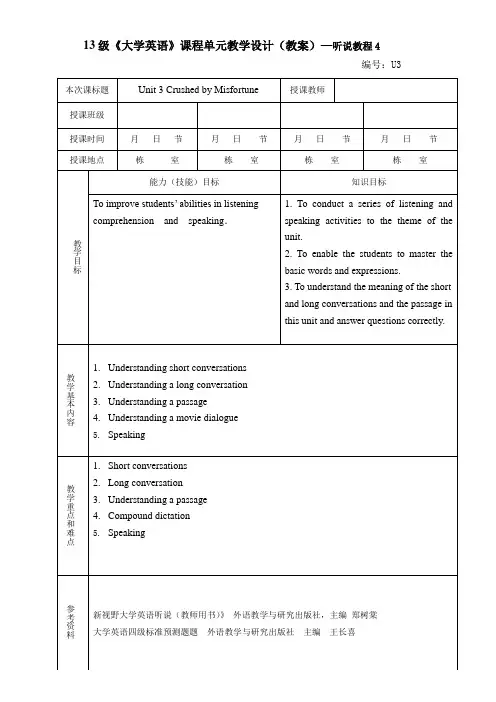
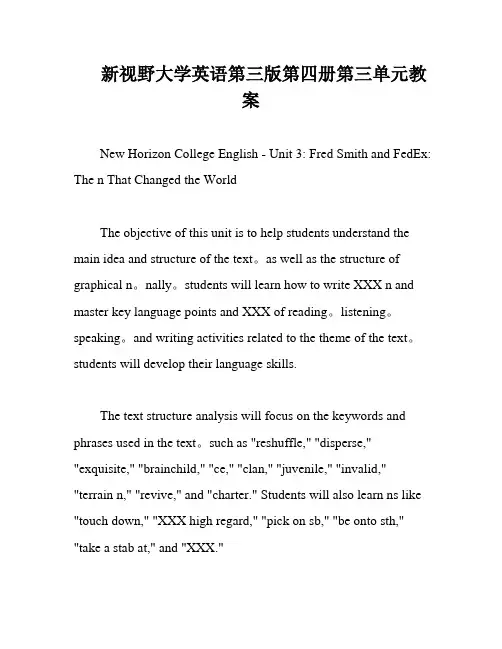
新视野大学英语第三版第四册第三单元教案New Horizon College English - Unit 3: Fred Smith and FedEx: The n That Changed the WorldThe objective of this unit is to help students understand the main idea and structure of the text。
as well as the structure of graphical n。
nally。
students will learn how to write XXX n and master key language points and XXX of reading。
listening。
speaking。
and writing activities related to the theme of the text。
students will develop their language skills.The text structure analysis will focus on the keywords and phrases used in the text。
such as "reshuffle," "disperse," "exquisite," "brainchild," "ce," "clan," "juvenile," "invalid," "terrain n," "revive," and "charter." Students will also learn ns like "touch down," "XXX high regard," "pick on sb," "be onto sth," "take a stab at," and "XXX."In terms of writing skills。
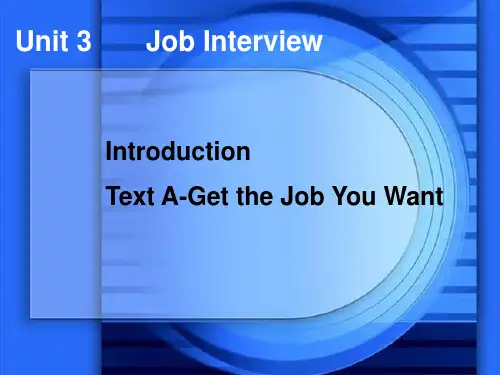
新视野大学英语读写教程Unit 3Being Entrepreneur^Teaching Objectives:Students will learn to use English toL To talk about the entrepreneurial spirit2.To understand the text fully3.To apply the phrases and patterns4.To master the essay writing skill*Time Allotment: each unit 8 classes1st…2nd classes: Part I Warming up1.Lead-in : Guessing activity and short answer questions2.Pre・reading activities: compound dictation3・ Cultural background: Proper names3rd-4th classes: Part II Text Study4. Reading in Depth: Structure Analysis, Summary, Difficult sentences analysis5e Language Focus: More practice in Language Points (language points explanation, Sentence Patterns, Useful Expressions)5th一6th classes: Part III Reflection6e Critical thinking: More speaking practice in discussion related to being entrepreneur.1.Writing Practice: Essay writing• Write a narrative with biographical information.7th一8th classes: Part IV Assignment7. Post-reading activities: summary of useful expressions, watching and discussing, speaking task, etc.8・ Section B: Focus on fast reading and practice in reading skillUNIT 3Section A Fred Smith and FedEx:The vision that changed the worldPart I Warming up1.Lead-in:1) Guess: Who is he/she?a. He was an American businessman, marketer and inventor. He revolutionized six industries: personal computers, animated movies, music, phones, tablet computing(平板电脑应用),and digital publishing. He died of cancer at the age of 56 in 2011.b- He is an American business magnate(巨头),philanthropist(慈善家),investor, computer programmer, and inventor. He has been top of the Forbes American rich list for consecutive(连续的)20 years. He was chairman of Microsoft company.c.He is an American programmer. He is best known as one of five co-founders of the world's largest social networking website. He is the chairman and chief executive of Facebook, Inc.d.He is a Chinese business magnate(大亨).He is the founder and Executive Chairman of a family of highly successful Internet-based businesses. His product is popular all around China.Tips: Steve Jobs; Bill Gates; Mark Zuckerberg; Jack Ma2)D iscussion question 1: Do you often use their products? Do their products make your life more convenient?Tips: Yes, I use their products quite often. I use various Apple electronics to work, play and socialize. I don't have to go to the library to search for information or gether materials...3) Discussion question 2: What is an entrepreneur?Tips: An entrepreneur is a person who makes money by starting or running businesses, especially when this involves taking financial risks.4)D iscussion question 3: What personal traits do successful entrepreneurs have in common?Tips: leadership, high motivation, great determination, willingness to fail, competitive spirit, budget-mindedness2.Prc-rcading activities:1) Compound dictationListen to a short passage concerning entrepreneur and fill in the missing information. The _____________ definition of an entrepreneur is a person who organizes and acceptsthe risks of a new business. Entrepreneurs may have a new product or service to____ • Or they may have ideas for new ways to do business. But an entrepreneurial spirit does not have to ________________ the business world.Lately we hear more and more about social entrepreneurs. What they do is __________ ; they might even act like business entrepreneurs. They might _____________ money in projects or get others to support them. But social entrepreneurs say they are not by a desire for profits. Their most important goal, they say, is to create social value. They organize and support programs that ______________________ improve conditions in communities. Social entrepreneurs say they look for solutions to needs without leaving them to government or industry to solve. And they say they try to _______________ the solution. In other words, to change the system, they try to get whole societies to change. There are many historical examples of people who might be called social entrepreneurs. Susan B. Anthony, for example, ________________________ women's rights in the United States. Vinoba Bhave created the Land Gift Movement to help India's poor andKeys: traditional, offer, be limited to, similar, invest, guided, aim to, spread, fought for, landless3.Cultural Background:1)the Millionaire^ UnitIt is the nickname for the First Yale Unit, a naval air reserve unit considered to be the first in the United States. It was started by F. Trubee Davison, a Yale sophomore at the time, in 1915. The unit had 29 members who were all wealthy and fascinated by flying・ Their intention was to learn to fly airplanes so as to develop Americans military aviation.2)the Marines(海军陆战队)Formerly called the United States Marine Corps, it is a branch of the United States Armed Forces responsible for providing power projection from the sea.3)the “hub and spoke” sys tem(轴辐式空中交通系统)It is a system which makes transportation much more efficient by routing all of the traffic through one or a few central hubs. The FedEx company took advantage of this idea in the 1970s, revolutionizing the way airlines were run.4)Xerox and GoogleXerox: an American multinational document management corporation that produces and sells printers, photo copiers, etc.Google: an American corporation which provides internet-related products and services.Part II Text Study1 ・ Main idea & structure:Tips for Reading: A Good Reader should1)Try to become an active reader.2)Learn to ask more questions. ( what, why, how)3)Do the efficient reading, (key points, topic sentence, key words, locating words,necessary and sufficient)4)Develop a habit of marking during reading.Answer Oucstions1)What type of business does FedEx mainly do?Tips: overnight delivery service; door-to-door package delivery (Para. 1)2)In what way did Smith's Childhood experiences contribute to his business later in life?Tips: suffering from a disease; picked on by bullies; learned to defend himself (Para. 3)3)How did Smith put his passion in flying into real practice before he started his business?Tips: operated a crop-duster at 15; helped revive the Yale flying club as a student; ran a small charter operation in New Haven; served in the Marines during the Vietnam War and flew more the 200 missions (Para. 4-7)4)What did Smith do in his term paper for his ecomonics class? How was the paper evaluated by his professor?Tips: drafted a prototype for a transportation company; wasn't impressed (Para. 5)5)What idea did Smith learn from his military experience? How did he relate the idea to his business later?Tips: leadership; Good leadership has very measurable effects on a company f s bottom line. (Para. 7)6)Why does the author mention the words Xerox and Google in the text?Tips: To show that FedEx is so successful that the name itself defines and represents express delivery・(Para. 10)7)What does Smith consider as the key elements for a successful business?Tips: appealing product or service and a compelling strategy; efficient management system; good leadership (Para. 11)8)What does Smith's great concern for his employees illustrate?Tips: his P-S-P philosophy (Para. 12)Structure Analysis:Introduction:Basic introduction to Smith and his FedEx company. (Para. 1)Smith is "recognized as an outstanding entrepreneur with an agreeable and winning personality^. (Para. 2)Body:Section One: Smith's early life experiences. (Para. 3・7)Section Two: Smithes business experience. (Para・ 8-11)Conclusion:Further description of Smithes friendly and agreeable personality and the significance of his P-S-P philosophy. (Para. 12)nguage Focus:Useful expressions:1)touch down (飞机等)降落,着落尽管天气恶劣,直升机飞行员还是设法安全地着陆在航空母舰的甲板上。
Unit 1, Book FourI. Section A: The Tail of Fame1. Teaching Objectives:λTo know the meaning and usage of some important words, phrases and patternsλTo be familiar with the writing skills of the text and make use of it in writingλTo improve Ss’ rea ding skills by studying section BTo respond and cooperate with classmates willinglyλTo participate activelyTo read sentences and texts with proper intonationλTo write smoothly and legibly2.Time Allotment:Section A (3 periods):1st---2nd period: Pre-reading activities ( theme-related questions for warming up;)While-reading activities (cultural notes; useful words and expressions;difficult sentences)3rd period: While-reading activities (text structure; main ideas)Post-reading activities (comprehension questions; exercises)Section B(1period):4th periods: Practice of the reading skill (reading for the key idea in a sentence);T checks on Ss’ home reading by asking questions based on the passage.T explains some difficult sentences3.Teaching Procedures:3.1 Pre-reading ActivitiesStep 1 GreetingsGreet the whole classStep 2. Warming upTeacher initiates students to talk about their special experiences during the newly-past vacationPurposes: Help students quickly adapt to the langguage-learning mode and facilitate students with English language atmosphere after a long vacation.Method: Talk in groups; communicative approach.Step 3. Lead-in and preparation for readingShow the Ss some pictures of famous people (the pictures might be the portaits of the famous people appearing in this Unit) and let Ss discuss with each other about the questions on the screen.1. For your understanding, how to define the word “fame” ?Fame refers to the state of being popular with a lot of people as a res ult of one’s achievement.2. What do people seek fame for?High social satus; abundance of material and spiritual fulfillment …3. What negative effects might fame bring about?Loss of privacy; deprivation of freedom …4. Do you want to live a life of celebrity? Enumerate some reasons to support your idea.Purpose: Arouse the students’ interest of study and lead Ss to Text A: The Tail of Fame.Method: Use the CAI, PPT software and talk in groups; Use task-based language teaching method, communicative approach, audio-visual method and audiolingual method.Step 4. Fast readingAsk the Ss to read the passage as quickly as they can and require them to answer the questions on Page 9. Make sure Ss grasp the main idea of the text and have a relatively clear understanding of the text structure.Text structure: ( the chart below )Purpose: Improve the students’ reading and writing ability and let students understand the general idea of the passage.Method: Read the text individually and talk in groups; Use task-based language teachingmethod, reading approach, communicative approach and total physical response method.Step 5. Preparation for details of the text on the screenSs are required to look at the words and phrases on the screen and give a brief presentation in class.Words and Phrases:Purpose:Train the Ss’ ability of understandi ng and using foreign language.Method: Talk in groups, Use task-based language teaching method, communicative approach and total physical response method.1)bankrupt: adj. without enough money to pay what one owesMany state-owned enterprises have gone bankrupt. 许多国有企业都破产了。
《新视野大学英语(第三版)》Book 4课程单元教学设计(教案)编号:U6-01《新视野大学英语(第三版)》Book 4课程单元教学设计(教案)编号:U6-02《新视野大学英语(第三版)》Book 4课程单元教学设计(教案)编号:U6-03《新视野大学英语(第三版)》Book 4课程单元教学设计(教案)编号:U6-04《新视野大学英语(第三版)》Book 4课程单元教学设计(教案)编号:U6-05over their words, the autocue malfunctioning, and the wrong guest being brought into the studio for an interview.3.Watch the video clip and match the people to the blunders.4.Watch the video clip again and fill in the blanks.5.Work in pairs and discuss the questions.1) Have you ever seen a newsreader make a mistake on TV? If yes, describe what it was or how it happened.Yes, I once saw a CCTV newsreader make a mistake. It happened in the evening news hour. The newsreader mispronounced a word, and she was embarrassed, but soon she became calm and continued to finish the broadcast.2)What kind of incident or error do you think is the most embarrassing for a newsreader?I think the most embarrassing incident for a newsreader might be a case when the microphone goes wrong. For example, a microphone stays on after the broadcast finishes, but the newsreader is unaware of this and thinks it has been switched off.Step Three (步骤三)Speaking for communicationRole-play1. Match the stories with the titles.e Euromillions Winnersa Scientists Find Life on Moonf Lions Save Girlc Prince Unhappy About Parking Penalty2. Listen to the conversations and underline the phrases that you hear.3. Speaking skillsAdding emphasisIn daily speech, you sometimes want to add emphasis to what you say in order to strengthen your point or draw more attention from the listener. The conversations you have just listened to provide typical examples of how to emphasize something. Here are four types of expressions and structures you can use.Rewrite the sentences to add emphasis.4. Work in pairs and role-play the following situations.Situation 1Talking about something impressive in recent newsSituation 2Being upset about a low exam scoreSituation 3Recommending an interesting campus activityGroup discussion1.Read the passage. Then work in pairs and check (✔) the true statements.2.Work with your partner and fill in the table.3.Work in groups of four and share with each other a TV program you like.4.As a group, choose a program that you would like to share with the rest of the class.5.Present the TV program you have chosen. Before you begin, refer to the checklist below to see if you are ready.Public speaking skillsAfter-dinner speechesAfter-dinner speeches are given at certain important events or celebrations to pay tribute to someone, to give thanks, or to acknowledge a special event. In giving an after-dinner speech, it is necessary to keep in mind three issues: (1) The theme or topic of the speech should be related to the event; (2) a clear point should be conveyed; and (3) the speech should be well-organized. A polished delivery with clear organization will help the audience understand the point made in the speech. Furthermore, the speaker should deliver the speech in a style he / she feels comfortable with, avoiding styles that he / she is not familiar with or not skilled at.Speaking practice:Suppose you are attending an alumni dinner. Give an after-dinner speech appropriate to the occasion. Follow the specific requirements given below:1 Choose a theme that suits the event.2 Decide on a point you want to make.3 Use adequate details to support your point, and organize them clearly.。